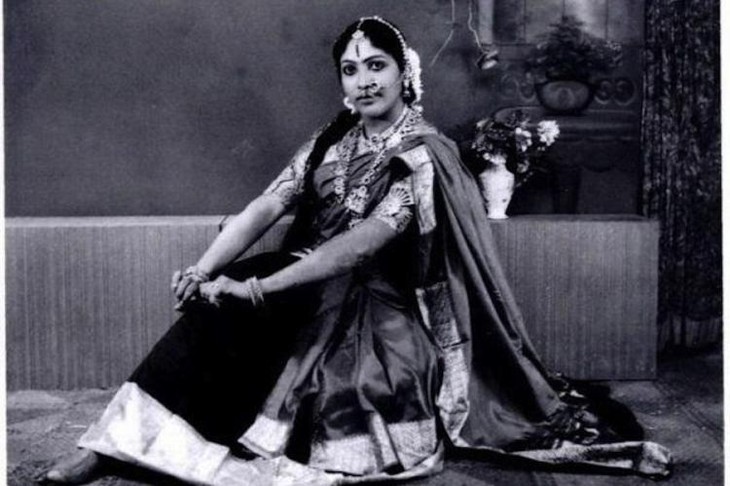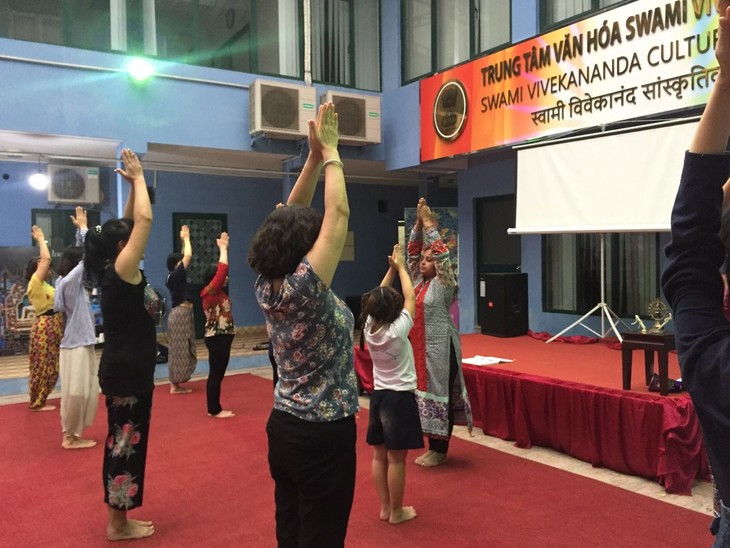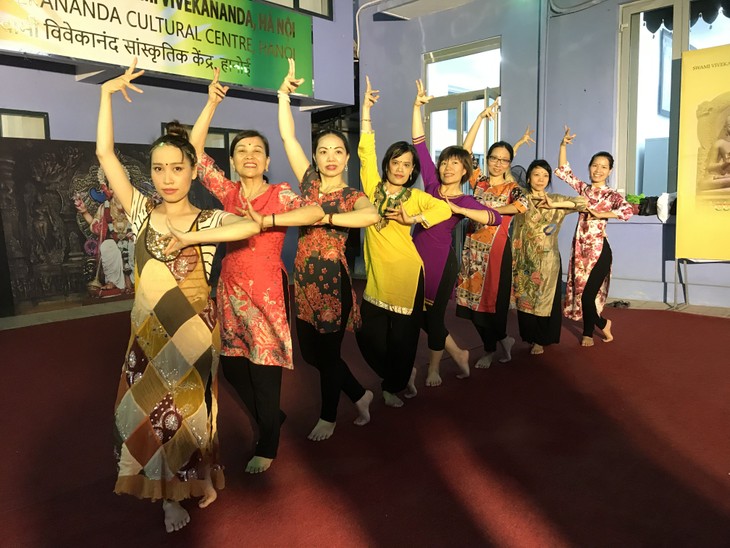 Kuchipudi dance teacher Kiranmai Bonala Kuchipudi dance teacher Kiranmai Bonala |
VOV Reporter: Welcome to our show, Ms. Bonala. Please tell us a little bit about yourself.
Kiranmai Bonala: I’m Kiranmai Bonala from south India, Hyderabad. I learnt dance from my mother and from her I did my diploma and after that I’ve done my MA in dance with a number of dance gurus.
VOV Reporter: So, what is kuchipudi? Can you tell us more about the dance, the history of the dance, its origin?
Kiranmai Bonala: In India, dance is a combination of GEETHAM - the song, VAADYAM – the instruments, and NRUTHYAM - the dance. These 3 combined together is called SANGEETHAM. So, dance is a part of Sangeetham, and according to Hindu mythology, dance came from heaven to overcome the bad with the good. And the Kuchipudi is one of the most popular dance forms in southern India, Andhra Pradesh. And kuchipudi is dance drama oriented. It’s like narrating some stories, in which you can play as a good character, a bad character, how the bad is overcome by the good. So we narrate and educate people with the dance form. Then the form for it came, and due to some great gurus, they have taught the dance to the ladies. Before that this dance was not taught to girls.
VOV Reporter: So before, just men danced, not the ladies?
Kiranmai Bonala: Yes, the men used to do the dance, even the girl’s parts. They used to dress as ladies and do the dance. But then dance guru Vedantam Lakshminarayana Sastri started teaching to the girls, and developed it. Now women are the most popular dancers in our field.
 Kuchipudi dance teacher Kiranmai Bonala Kuchipudi dance teacher Kiranmai Bonala |
VOV Reporter: So, how old is the dance?
Bonala: It started in the 10th century and in the 17th century Tirtha Narayanayati and his disciple Sidhyendra Yogi, fixed a parameter in kuchipudi and they have developed what we are following today.
VOV Reporter: So the audience is the general public? Everyone likes watching the dance?
Bonala: Yes, everyone. There is no class, sex, or anything in this, everyone can easily understand and enjoy this dance form.
 Vishnu and Lakshmi characters in Kuchipudi dance. Vishnu and Lakshmi characters in Kuchipudi dance. |
VOV Reporter: Is it hard to learn and perform the dance?
Bonala: See, for any art, you need to dedicate yourself to it. Even if you want to become a normal housewife you need to dedicate yourself. If you need dedication to be a normal housewife, you also need it to be a dancer. If you are dedicated then it’s easy, but if not it will be hard. It depends upon the person, and upon the interest.
VOV Reporter: Yes, but what I meant is, in addition to dedication, is there something about the dance that makes it different from all other dances?
Bonala: Yes of course, we have mainly Kalapas, which is not in any other styles of dancing. We have Gollakalapam, which is the philosophy we are taught in the subject. And Bhamakalapam, a conversation between Satyabhama and Krishna, about the feeling between them. It’s a big story, and we learnt all the dialogues. That how we do the drama. That’s why kuchipudi is called dance drama. It’s a unique feature we have. And one more thing, we have a type of brass plate rim on which we balance and dance. We balance a pot full of water on our head with candles on our hand, and dance”
VOV Reporter: Is there something special about the movement of the dance?
Bonala: The dance has 2 elements, tandava and lasya. Tandava is strong, vigorous movements of the limbs and body. Lasya is graceful movements. Kuchipudi is mostly about graceful movements.
VOV Reporter: And what about the music and instrument accompanying the dance?
Bonala: In India, we have 2 types of music, one is Carnatic style from south India and one is Hindustani from north India. For Kuchipudi we use Carnatic style music. we also have gatram, and they can sing for the dance or concert only. Those who sing for concerts wont sing for dances because it’s difficult for them, or they don’t want to do both types. So in Kuchipudi, we have a singer who sings first. Previously, the dancer used to sing but nowadays we can playback singers. We also have cymbals but mainly the guru will do the cymbals part and direct the orchestra. Mridangam is our percussion instrument, we use Violin, Veena, a string instrument, and the flute as a wind instrument. 4 musical instruments and 1 singer and 1 guru so a minimum of 6 people should be on stage.
 Dance guru Vedantam Lakshminarayana Sarma Dance guru Vedantam Lakshminarayana Sarma |
VOV Reporter: So how long does it last? A dance I watched on Youtube lasted over 18 minutes. It was really long.
Bonala: Actually, when I was a kid, I saw one of the main pieces of kuchipudi for 3 days. It was that long. 3 days means each evening from 6 to 9pm. But I learnt that they used to do it over 7 days.
VOV Reporter: What is the story about? What story took 7 days to tell?
Bonala: It’s big but all the story consists of the same things, now we’re doing for half an hour. We can’t play for that many hours because no one will come, see and enjoy it. So now we will only do it in half an hour or 45 minutes, for example with Satyabhama entering the stage, introduce herself as the daughter of a great king and she is very beautiful and she is the wife of Krishna. That piece is done in 10 minutes. After that how she is talking to her saki or friend, telling her please call Krishna, he is not coming to her room for so many days because Krishna has 8 wives. The story is like that. We cut it to 40-45 minutes maximum, and when we need to we cut it down to half an hour.”
 A Kuchipudi dance class in India's Swami Vivekananda Cultural Centre in Hanoi A Kuchipudi dance class in India's Swami Vivekananda Cultural Centre in Hanoi |
VOV Reporter: So it’s mainly about history, right?
Bonala: Yeah, mainly about history. But in contemporary day we are already presenting on woman empowerment and we take on other social problems. We can’t directly tell our young generation how to be couraged, so we can tell them through a group presentation using each character, and we tell them how to overcome those problems, like about girls going alone in midnight. There are many cases, so we can’t just tell them ‘Don’t go out!’. Of course we need to go to work, so we need to overcome that by knowing self-defense. We can even tell history of great kings and queens. Not just about the mythological parts but today we do more about social awareness, like about how education is important, how pressure should be balanced. That’s the main things because the young generation today don’t know how to balance their stress level. When we teach, we tell them to concentrate on the dance to relax, don’t think about any other things. So you forget the stress. In India we are even doing dance therapy to make people have more energy, become able to enjoy and love their life.
VOV Reporter: What about the costumes, like the dress you wear when you dance?
Bonala: In the past, we used to wear a six-yard sari. But now we wear pants and put frills on that so it looks like a Sari. Inside there are pants, a blouse and a (palu we call it) and frills and seed beads. So there are 5 items to wear, and as for the ornaments we use a head set on theme of sun and moon, earrings, necklaces, and the belt.
 A Kuchipudi dance class in Hanoi A Kuchipudi dance class in Hanoi |
VOV Reporter: So how long does it take you to master the dance?
Bonala: I don’t know, it’s a life-long learning process. But the minimum training needed is at least 10 years. I started when I was 4, my mom taught me even before that, but officially the minimum is 5 to 6 years, when starting kindergarten. We let our kids have dance lessons because it cannot come in 1 or 2 days. The first 2-3 year is about developing insidely and learning the disciplines, how to go to class, how to sit, where to put their shoes, these are the things they need to learn first. Then they will start to learn body warmups and everything, then learn the dance. It takes time, 10 years.
VOV Reporter: Now, a final question. Is there anything special about the dance you’d like to share with us from your nearly 40 years of dancing?
Bonala: Dance is my first love. According to me, everyone should dance and everyone is a dancer. Because when we want to talk without opening our mouth, the obvious thing to do is dancing, if you use your body it’s like dancing. When you do something it should be good to the world, not bad at least.
VOV Reporter: Thank you so much! We wish you and your family all the very best!